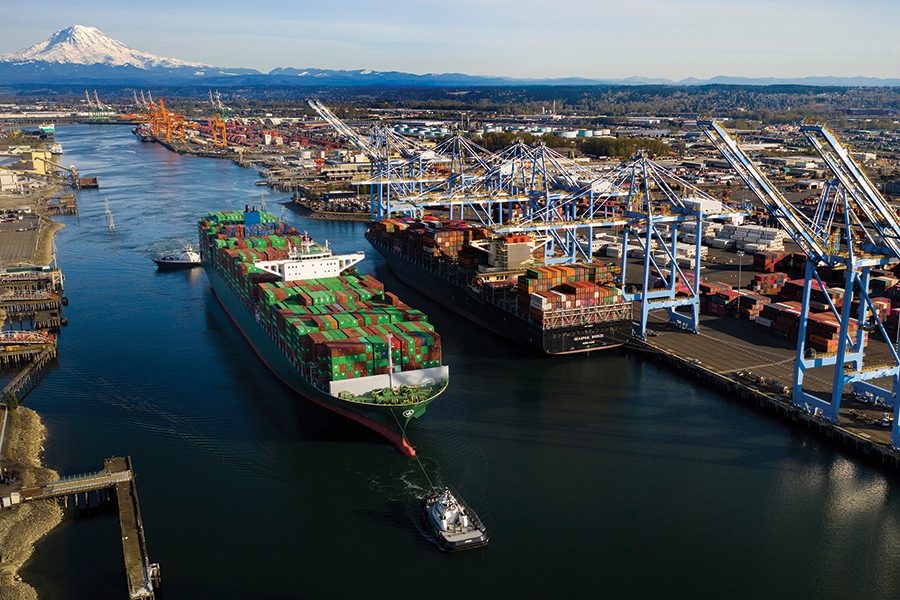
Home » Ag exporters left behind as consumers shop online
Ag exporters left behind as consumers shop online

June 14, 2021
A side effect of the Covid-19 pandemic is hurting Washington’s ability to export its fresh cherries, apples, frozen french fries and other signature products to the rest of the world.
A shipping container shortage sparked by frenzied online shopping is the latest complication faced by farmers and ranchers, who have been battered by difficult trade conditions in recent years.
For 2020, exports of Washington-produced agriculture products dropped 5% to $6.7 billion compared to 2019, according to figures finalized by the state Department of Agriculture in May 2021.
An additional $10 billion of crops grown elsewhere moved through Washington ports in 2020, pushing the total value to more than $17 billion.
“It is better than I expected,” said Rianne Perry, international marketing manager for the state agriculture department. “A 5% decrease is better than I would have expected. I was a bit surprised.”
Perry was pleasantly surprised a year ago when the 2019 figures showed a modest gain to about $7 billion as tough trade talks gave way to a series of new trade agreements, including the United States-Mexico-Canada Agreement (USMCA) known as the “new” NAFTA, the United States-China Phase One Trade Agreement and a trade agreement with Japan, which eased tariffs and market access for Washington-grown products.
But the Covid-19 pandemic began affecting Asian customers in January 2020 and roiled the U.S. starting in March 2020.
“If Covid hadn’t come along, our trajectory was to increase. There was no reason to decrease. I see it as being completely due to Covid,” she said.

A mixed bag
The result is a mixed bag for ag exporters. Four of Washington’s top five crops saw declines. Wheat exports were a bright spot, rising 13% to $663 million, partly because China came under pressure to comply with the new Phase One terms.
The news was less pleasant for other products. Fish and seafood fell by 12% to $1 billion.
Frozen french fries, which are produced chiefly in the Mid-Columbia, fell by more than 11% to $784 million. Apples, the state’s signature crop, fell 13% to $637 million. Hay fell 2%, to $508 million.
Dairy exports grew 12% to $500 million. Fresh sweet cherries fell by 2% to $342 million.
Pulses – dry-harvested grains – had the biggest gain, rising 20% to $170 million.
The new trade agreements with China, Japan, Mexico and Canada appear to be improving the overall picture, but a container shortage in the shipping industry is a cause for concern.
Losing to retail
Agriculture is competing with – and losing to – retail when it comes to ocean liners.
Put simply, shipping containers leave Asia laden with sneakers, electronics and any number of items destined for U.S. customers. Ocean carriers send the containers back to Asian ports as fast as they can, unwilling to sideline them long enough to fill with ag products that ship by container.
The number of empty containers leaving Washington ports soared in the first quarter of 2021, according to the Northwest Seaport Alliance, consisting of the ports of Seattle and Tacoma. In its monthly shipping update, it said 154,131 empty containers left the ports in the first three months of 2021 compared to 101,006 in all of 2020.
The ports are preparing “near dock” facilities to give faster access to containers to Washington exporters by reducing the turnaround time, said Melanie Stambaugh, spokeswoman for the seaport alliance.
The challenge is complicated by the number of containers being transferred by rail to the Midwest, leading to an imbalance.
The system, she said, was not designed to handle the volume of imports caused by pandemic-induced shopping on Amazon and other websites – a cultural shift that may prove permanent.
The fallout is hardest on ag exporters.
“It is really problematic. It’s hindering the amount of exports going out,” said Perry, who added communications issues mean exporters may only learn a carrier won’t call after products are
en route to the port.
The Federal Maritime Commission and Congress are reviewing the crisis.
In a March 9, 2021, letter signed by more than 100 members of Congress, U.S. Rep. Dan Newhouse, R-Sunnyside, together with U.S. Rep. Cathy McMorris Rodgers, R-Spokane, and U.S. Rep. Kim Schrier, a Democrat whose district extends from Bellevue to Yakima, called on the chair of the maritime commission to act quickly to stem the tide of empty containers.
American exporters are grappling with delays, bottlenecks and increased port fees, the bipartisan letter complained. Delivering shipments to U.S. ports and leaving without refilling empty containers is unsustainable and “simply unacceptable,” it said.
“Should it be found that (carriers) are predatory or unreasonable in refusing to export these American agricultural products or imposing unreasonable fees, they must be held accountable.”
Perry is grateful for the support, but said immediate relief is not a realistic expectation.
“It won’t help right now,” said Perry, who added that the inability to ship products hurts relationships with partners who view their U.S. suppliers as “unreliable.”
Trade deals take hold
The container shortage is the latest challenge to beset the Washington ag industry’s modern export saga, which dates to 2017. Then President Donald Trump removed the U.S. from the Trans-Pacific Partnership (TPP) and escalated conflict with China, leading to retaliatory tariffs on many Washington products, and renegotiated trade deals with Canada and Mexico.
The TPP deals remain a major challenge for Washington because the remaining countries proceeded with the deal, excluding U.S. exporters from favorable duty treatment. A separate U.S.-Japan deal is helping, she said.
“Our products are so much more expensive than the competitors (within the partnership). It is continuing to be a problem,” she said.
The USMCA took effect July 1, 2020, and left Washington exporters mostly untouched.
Perry said Washington wines are getting better treatment in Canadian stores, but Washington dairies won’t reap the benefits of favorable terms with Canada because most terminals are in the middle of the country.
Exports to Canada were off slightly, while those to Mexico plummeted, which Perry attributes to the pandemic.
Exports to Mexico dropped 17% to $316 million in 2020, causing it to slip a spot to Washington’s sixth largest agriculture trading partner.
Perry is optimistic Mexico will revive in 2021, as its “chaotic” Covid-19 situation and recession ease.
Frozen french fries were the one bright spot. Mexico bought $38 million in 2020, a 4.4% increase. All other categories fell.
Mexico was Washington’s second largest market for apples ($114 million) and largest market for pears ($28 million), malt ($11 million) and roasted coffee ($11 million). Frozen vegetable sales fell 40%, to $6 million.
The Phase One deal with China was signed Jan. 15, 2020, and committed China to buying at least $40 billion of U.S. food, agriculture and seafood products annually for a total of at least
$80 billion by the end of 2021.
Washington exports to China grew 12% to $518 million in 2020. China is the second largest market for Washington-grown hay and the third largest market for its fish and seafood and for fresh sweet cherries.
Perry cautions that the 12% gain does not erase the 42% decline posted between 2017-19, the height of the trade wars.
“The increases are big, but they’re not anywhere close to where they were before,” she said.
The Phase One deal drove increases in hay exports and was particularly helpful for pulses (dry-harvested grains), which grew by 365%; for wheat, which grew by 900%; and for dairy, which grew by 400%.
Beef exports to China are worth calling out. Washington exported $13 million worth of beef to China in 2020, a 169,263% gain over the prior year’s miniscule number.
“That is not a typo,” said Perry, who said China only began buying Washington beef a few years ago, so nominal increases magnify the impact.
Focus Magazine Agriculture + Viticulture
KEYWORDS june 2021





